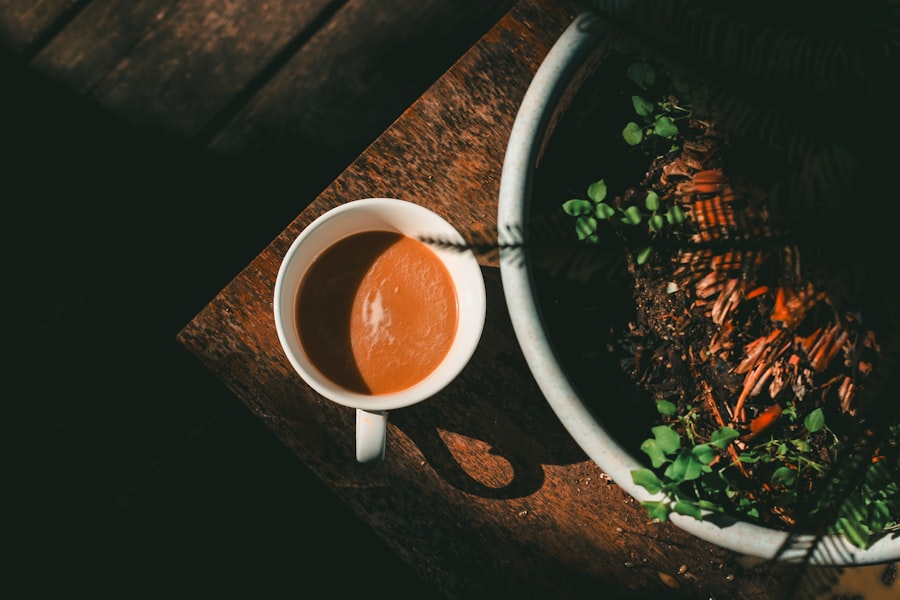Now Reading: Celebrating International Coffee Day: A Toast to Our Favorite Brew
-
01
Celebrating International Coffee Day: A Toast to Our Favorite Brew
Celebrating International Coffee Day: A Toast to Our Favorite Brew

International Coffee Day, celebrated annually on October 1st, has evolved into a global phenomenon that honors one of the world’s most beloved beverages. The origins of this day can be traced back to 2015 when the International Coffee Organization (ICO) officially designated it as a day to promote coffee consumption and raise awareness about the plight of coffee farmers. However, the roots of coffee itself extend far deeper into history, with its discovery believed to have occurred in Ethiopia around the 9th century.
Legend has it that a goat herder named Kaldi discovered the energizing effects of coffee beans after observing his goats becoming unusually lively after consuming them. As coffee spread across the globe, it became a significant commodity, influencing trade routes and economies. By the 15th century, coffee was cultivated in the Arabian Peninsula, and by the 17th century, it had made its way to Europe, where it quickly gained popularity.
Coffeehouses emerged as social hubs, fostering intellectual discussions and cultural exchanges. The establishment of International Coffee Day serves not only to celebrate this rich history but also to highlight the ongoing challenges faced by coffee producers worldwide, including climate change and economic instability.
Key Takeaways
- International Coffee Day was first celebrated in 2015, initiated by the International Coffee Organization to promote fair trade and raise awareness about the coffee industry.
- Coffee has a significant global impact, with over 125 million people depending on coffee for their livelihoods and it being the second most traded commodity in the world after oil.
- The art of brewing the perfect cup involves factors such as water temperature, grind size, and brewing time, all of which contribute to the flavor and aroma of the coffee.
- Coffee culture varies around the world, from the strong and sweet Turkish coffee to the leisurely and social coffee rituals in Italy and the specialty coffee shops in the United States.
- Coffee has various health benefits, including improved cognitive function, increased metabolism, and a reduced risk of certain diseases such as Parkinson’s and Alzheimer’s.
The Global Impact of Coffee
Coffee is more than just a beverage; it is a multi-billion dollar industry that significantly impacts economies and societies worldwide. According to the International Coffee Organization, approximately 125 million people depend on coffee for their livelihoods, with millions more involved in its production, distribution, and consumption. The global coffee market is valued at over $100 billion, making it one of the most traded commodities after oil.
Countries such as Brazil, Vietnam, Colombia, and Ethiopia are among the largest producers, contributing to their national economies and providing employment opportunities. The environmental impact of coffee cultivation is profound as well. Coffee farming can lead to deforestation and biodiversity loss if not managed sustainably.
However, when practiced responsibly, coffee cultivation can promote reforestation and support local ecosystems. The demand for specialty coffees has also led to an increase in sustainable farming practices, which prioritize environmental health while ensuring fair wages for farmers. This dual focus on economic viability and ecological responsibility is crucial for the future of coffee production.
The Art of Brewing the Perfect Cup

Brewing the perfect cup of coffee is both an art and a science that requires attention to detail and an understanding of various brewing methods. The process begins with selecting high-quality beans, which should be freshly roasted to preserve their flavor profile. The grind size is critical; for instance, a coarse grind is ideal for French press brewing, while a fine grind is necessary for espresso.
Water quality and temperature also play significant roles in extraction; ideally, water should be between 195°F and 205°F for optimal brewing. Different brewing methods yield distinct flavor profiles and experiences. For example, pour-over techniques allow for greater control over extraction time and water flow, resulting in a clean and nuanced cup.
Conversely, espresso machines use high pressure to extract concentrated flavors quickly. Experimenting with various brewing methods can enhance one’s appreciation for coffee and reveal the diverse characteristics inherent in different beans. Ultimately, brewing the perfect cup is about personal preference; finding the right balance between strength, acidity, and flavor notes is key.
Coffee Culture Around the World
| Country | Coffee Consumption per capita (kg/year) | Number of Coffee Shops | Popular Coffee Drinks |
|---|---|---|---|
| Italy | 5.9 | 150,000 | Espresso, Cappuccino |
| United States | 4.2 | 35,616 | Americano, Latte |
| Brazil | 6.0 | 22,000 | Cafézinho, Cappuccino |
| Japan | 3.3 | 83,000 | Doppio, Macchiato |
Coffee culture varies significantly across different regions, reflecting local traditions and social practices. In Italy, espresso is not just a drink but a ritual; Italians often enjoy their coffee standing at the bar, engaging in lively conversations. In contrast, Turkish coffee is steeped in tradition, served unfiltered in small cups with grounds settling at the bottom.
The preparation process itself is an art form, often accompanied by rituals that emphasize hospitality. In Scandinavian countries, particularly Finland and Sweden, “fika” is a cherished tradition that involves taking a break to enjoy coffee alongside pastries or snacks. This practice underscores the importance of social connections and relaxation in daily life.
Meanwhile, in Japan, coffee culture has taken on a unique twist with the rise of specialty cafes that focus on meticulous brewing techniques and aesthetic presentation. Each culture’s approach to coffee reflects its values and social norms, making coffee not just a beverage but a medium for connection and expression.
Health Benefits of Coffee
Numerous studies have highlighted the potential health benefits associated with moderate coffee consumption. Research indicates that coffee may reduce the risk of several chronic diseases, including type 2 diabetes, Parkinson’s disease, and certain types of cancer. The presence of antioxidants in coffee contributes to its health-promoting properties by combating oxidative stress in the body.
Moreover, caffeine—a natural stimulant found in coffee—can enhance cognitive function and improve mood by increasing alertness and concentration. Some studies suggest that regular coffee drinkers may experience a lower risk of depression and improved mental well-being. However, it is essential to consume coffee in moderation; excessive intake can lead to adverse effects such as anxiety or insomnia.
Understanding individual tolerance levels is crucial for maximizing the health benefits while minimizing potential drawbacks.
Sustainable Coffee Practices

Sustainability in coffee production has become increasingly important as consumers become more aware of environmental issues. Sustainable practices encompass various approaches aimed at reducing the ecological footprint of coffee farming while ensuring fair treatment for farmers. Shade-grown coffee is one such practice that promotes biodiversity by allowing other plants to thrive alongside coffee trees, creating a balanced ecosystem.
Additionally, certifications such as Fair Trade and Rainforest Alliance help consumers identify products that adhere to ethical standards regarding labor practices and environmental stewardship. These certifications ensure that farmers receive fair compensation for their work while encouraging sustainable farming methods that protect natural resources. By supporting sustainable coffee practices, consumers can contribute to a more equitable and environmentally friendly industry.
Coffee Cocktails and Creative Recipes
The versatility of coffee extends beyond traditional brewing methods; it can also be incorporated into cocktails and creative recipes that tantalize the palate. Coffee cocktails have gained popularity in recent years, with mixologists experimenting with various flavors and ingredients to create unique beverages.
For those looking to explore beyond cocktails, coffee can be used in desserts such as tiramisu or affogato—where hot espresso is poured over vanilla ice cream for a delightful contrast of temperatures and flavors. Additionally, incorporating spices like cinnamon or cardamom can elevate the taste profile of both drinks and desserts. The creative possibilities are endless; experimenting with different ingredients can lead to exciting new flavor combinations that celebrate the rich essence of coffee.
Coffee and Mental Well-being
The relationship between coffee consumption and mental well-being has garnered significant attention in recent years. Caffeine’s stimulating effects can enhance mood and cognitive function by increasing dopamine levels in the brain—often referred to as the “feel-good” neurotransmitter. Many individuals report feeling more alert and focused after consuming coffee, which can contribute positively to productivity and overall mental health.
However, it is essential to recognize that individual responses to caffeine vary widely; while some may experience heightened energy levels and improved mood, others may encounter anxiety or jitteriness with excessive consumption. Striking a balance is crucial; moderate intake—typically defined as 3-4 cups per day—can provide mental benefits without adverse effects. Additionally, incorporating mindful practices such as savoring each sip can enhance the overall experience of drinking coffee while promoting relaxation.
Exploring Different Coffee Varieties
The world of coffee is incredibly diverse, with numerous varieties offering distinct flavors and aromas influenced by factors such as region, altitude, and processing methods. Arabica and Robusta are the two primary species cultivated globally; Arabica beans are known for their smooth flavor profile and lower caffeine content, while Robusta beans are characterized by their bold taste and higher caffeine levels. Within these species exist countless cultivars that showcase unique characteristics based on their growing conditions.
For instance, Ethiopian Yirgacheffe beans are celebrated for their floral notes and bright acidity, while Colombian Supremo beans offer a well-balanced flavor with hints of caramel. Exploring different varieties allows enthusiasts to appreciate the complexity of flavors inherent in each bean while discovering personal preferences.
Supporting Coffee Farmers and Fair Trade Practices
Supporting coffee farmers through fair trade practices is essential for fostering sustainable livelihoods within the industry. Fair Trade certification ensures that farmers receive fair prices for their products while adhering to ethical labor standards. This model empowers smallholder farmers by providing them with access to international markets and resources necessary for improving their agricultural practices.
Consumers play a vital role in this process by choosing Fair Trade-certified products when purchasing coffee. By doing so, they contribute directly to improving living conditions for farmers and their communities while promoting environmentally sustainable practices. Additionally, initiatives such as direct trade relationships between roasters and farmers further enhance transparency within the supply chain—ensuring that producers receive equitable compensation for their hard work.
The Future of Coffee: Trends and Innovations
The future of coffee holds exciting possibilities driven by innovation and evolving consumer preferences. One notable trend is the rise of specialty coffees that emphasize unique flavor profiles sourced from specific regions or farms—often referred to as “single-origin” coffees. This trend encourages transparency within the supply chain while allowing consumers to explore diverse tastes.
Moreover, advancements in technology are transforming how coffee is produced and consumed. From precision agriculture techniques that optimize crop yields to innovative brewing equipment that enhances flavor extraction—technology plays a crucial role in shaping the future landscape of coffee production. Additionally, sustainability initiatives continue to gain momentum as consumers increasingly prioritize environmentally friendly practices when making purchasing decisions.
In summary, International Coffee Day serves as a reminder of the rich history and cultural significance surrounding this beloved beverage while highlighting its global impact on economies and communities alike. From exploring diverse brewing methods to understanding health benefits associated with moderate consumption—coffee remains an integral part of daily life for millions worldwide. By supporting sustainable practices and fair trade initiatives, consumers can contribute positively to the future of this cherished commodity while enjoying its myriad flavors and experiences.
Coffee Day, celebrated by coffee enthusiasts worldwide, is a perfect occasion to indulge in your favorite brew and explore new coffee trends. While sipping on your cup of joe, you might also want to consider some leisure activities to complement your coffee experience. For instance, if you’re planning a cozy day indoors, you could explore some entertainment options. An interesting read is an article on












